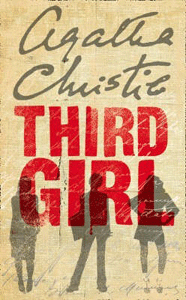In “Third Girl” (1966) we really see Agatha Christie moving into the Sixties and musing about being out of touch with changing times. She had tapped into this vibe before, but never so clearly as when the dirty bohemian girl of the title comes to Poirot for help, then dismisses him for being too old.
Mrs. Oliver helps out
The story is wordy and repetitive by Christie standards, but still readable as always. She digs into changing fashions and behaviors among young people, with Poirot and his author friend Ariadne Oliver noting that youths aren’t so much impolite as they are simply a new generation. But they’re kind of making excuses for them. (And indeed, the final pages feature such a sudden marriage proposal that it’s like the author is rebuking modern times.)
The titular Norma definitely has an arty boyfriend, David, and she’s possibly into the drug scene. Either that or she has natural psychological issues. “Third Girl” opens with this corker: Norma tells Poirot she thinks she may have murdered someone.

“Third Girl” (1966)
Author: Agatha Christie
Genre: Mystery
Series: Hercule Poirot No. 31, Ariadne Oliver No. 6
Setting: London and Long Basing, 1966
This kicks off an unusually long stretch of information-gathering by Poirot – with help from Mrs. Oliver, the eye-contact-challenged Mr. Goby (from “Funerals are Fatal”), sly psychiatrist Dr. Stillingfleet and competent Chief Inspector Neele. But meanwhile, there’s no actual murder! Poirot famously doesn’t approve of murder, but he’s starting to get frustrated by this missing puzzle piece.
“Third Girl’s” biggest treat is that Mrs. Oliver, usually a spice more than a main dish, is finally used substantially. Despite Poirot’s worry about her safety, Mrs. Oliver (who refers to herself as “elderly,” thus continuing that theme) pursues Norma and David. She ends up getting hospitalized, but still serves as an amusing (to us) and bemused (from her POV) sounding board for Poirot.
Movin’ on up
The second-biggest treat is the big jump in modernization among Christie’s catalog. A London high-rise apartment building, Borodene Mansions, is a major setting. Norma lives in a unit as the “third girl,” a term Oliver teaches to Poirot.
Claudia is the first girl: She rents the unit and has the biggest bedroom. Frances is the second girl: She plays a lesser share of the rent and gets the second-biggest bedroom. Norma is the third girl: She pays less rent still and has the smallest bedroom.
The first two girls are friends, whereas the third had been sought out for rent-sharing purposes. This setup has become common. These young women work different jobs, only occasionally cross paths, and don’t keep close tabs on each other.
This new way of living contrasts with the not-so-long-ago days when children lived with their families until they got married – and then sometimes continued to live in the same large house. This setup is seen in many older Christie novels, and even in “Third Girl” to a degree: Norma also has a room in the country home where her father and stepmother live.

The home actually belongs to an older relative, who also has an au pair helping him on his memoirs. “Third Girl” is absolutely packed with characters. It’s the sheer size of the cast that makes the mystery challenging to solve, rather than any originality in the solution.
Comfortable tropes
Indeed, the salient points – women’s ability to change their appearance, a psychologically imbalanced woman, and a man’s mysterious lost years in Africa – had been used by Christie before. Drugs (particularly as used to manipulate – or sometimes kill – a person) are a longtime staple of Christie’s. But she’s particularly interested in the fashionable drugs of the Sixties here.
Still, “Third Girl” does develop its own identity. Christie’s portrayal of this new common domestic arrangement for young single women, the peek into the beatnik art scene, and Poirot’s various assistants pounding the pavement give “Third Girl” energy and richness.
At one point, Poirot is frustrated by an interrupting phone call from Ariadne (she had forgotten to tell him a key piece of info) when he’d prefer to sit and think. Once he gets an actual murder to slot into his theorizing, he’s able to sort things out from his armchair.
For readers, “Third Girl” is perhaps solvable because of the familiar tropes and Christie’s odd repetition of the points (as if she’s trying to keep them straight herself). Whether you want to sit and mull them yourself or read through to Poirot’s solution is up to you.
You’ll be satisfied either way, although it’s the trappings of the changing Sixties that make “Third Girl” stand out.
Sleuthing Sunday reviews an Agatha Christie book or adaptation. Click here to visit our Agatha Christie Zone.

